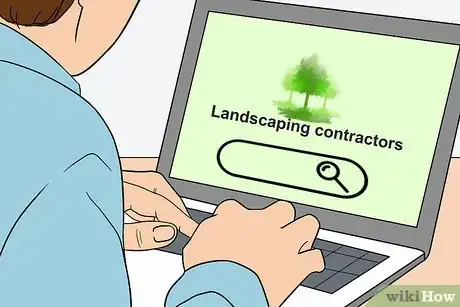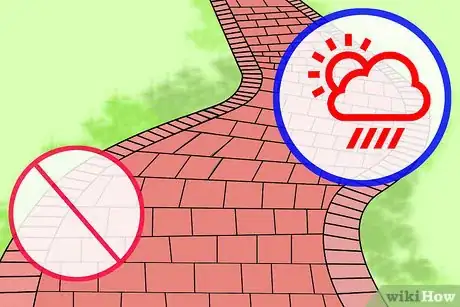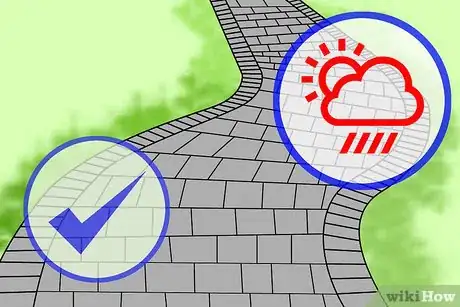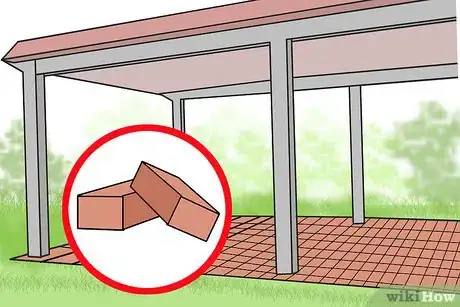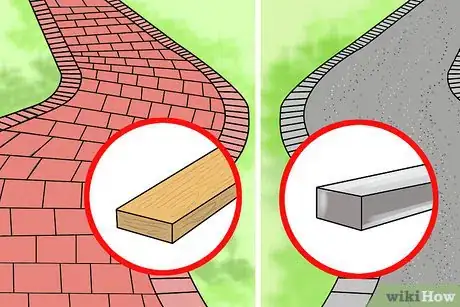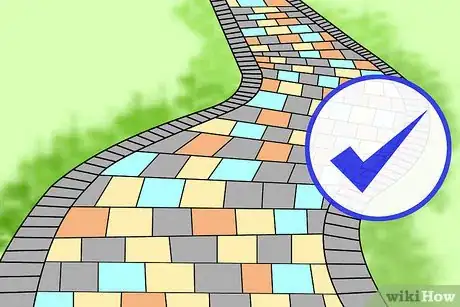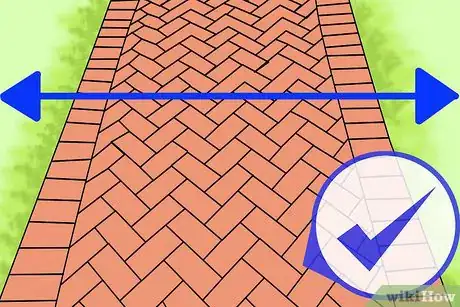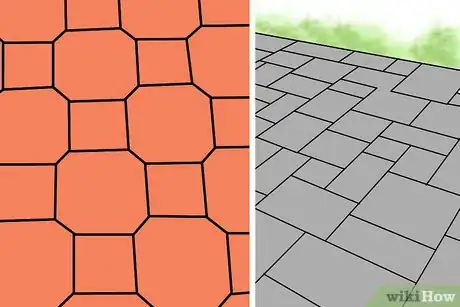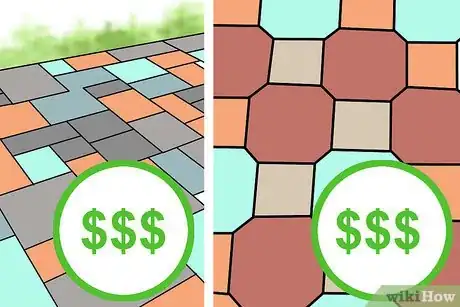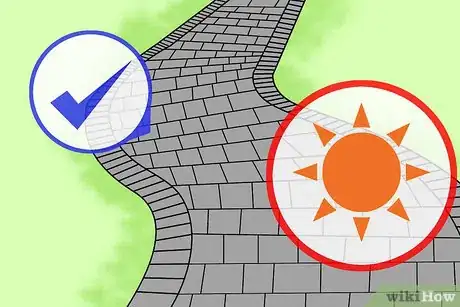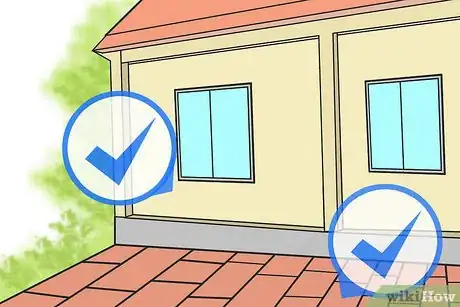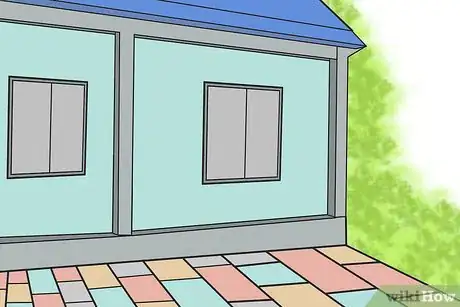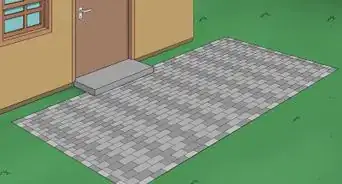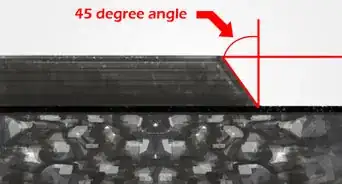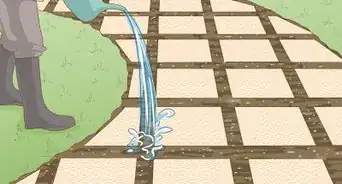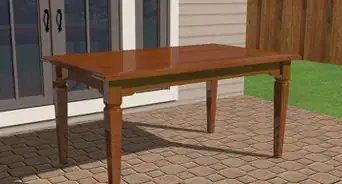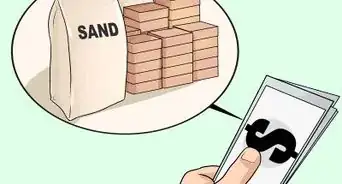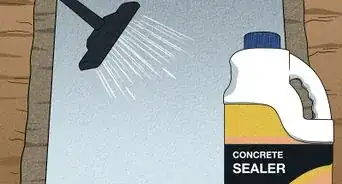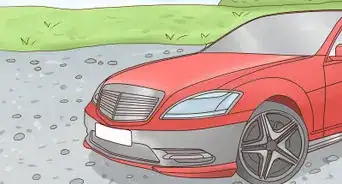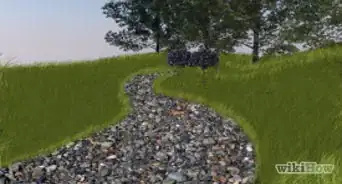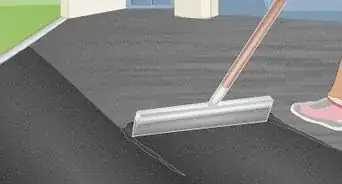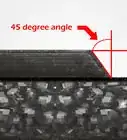This article was co-authored by Tony Hoang. Tony Hoang is a Landscaper and the Principal at H&J Landscaping & Concrete Contractor in Newark, CA. With over six years of experience, he specializes in designing the perfect concrete driveways & backyard patios for homes. H&J Landscaping & Concrete Contractor is a 4.5-star business on Yelp.
There are 14 references cited in this article, which can be found at the bottom of the page.
This article has been viewed 28,152 times.
Pavers can help you create a patio when building an actual patio isn’t possible. They can also provide lovely stepping stones for your garden. While pavers are wonderful, choosing pavers takes time and consideration, as you need materials and shapes that are functional and suit your space. When looking for pavers, be sure to pay close attention to your budget, while also thinking about the material, shape, and color you most desire.
Steps
Choosing Paver Material
-
1Research the prices of pavers and labor. Use your favorite online search engine to find landscaping contractors in your area. Call at least three to five to compare the prices of parts and labor and their estimated timelines for finishing the project. You should also ask them for client referrals on past projects, and double check that they’re a licensed contractor or business that has worker's compensation insurance. They should also be liability insured.[1]
- Don’t be afraid to haggle! Prices are rarely set in stone.
- Ask them if they have special off-season or end-of-season rates.
- Your price tag will vary depending on where you live and how big your patio is. However, installing brick pavers for a 120-square foot (11-square meter) patio in an average town in the United States should cost between about $1,200-$1,800, or about $10-$16 per square foot (0.09 square meter).[2] Concrete may be slightly cheaper, costing between about $8-$15 per square foot (0.09 square meters).[3]
-
2Choose pavers that work for your climate. Brick is a porous substance, and may break down more quickly than concrete in areas with a lot of rain, heat, or wind. If you live in a moderate climate, however, brick is likely to weather well. Concrete and stone hold up better in harsh climates.[4]
- If you live somewhere with extreme weather conditions, look for brick designed for inclement weather.
- Pavers are typically made from concrete, stone, or brick, and each material has its own unique benefits and drawbacks.
- If you live in a harsh climate but love the look of brick or limestone, go for it! You may simply need to work paver replacements into your yearly house budget. The cost of replacement will depend on the material and the extent of the damage, but it should cost between about $300-$3,000.[5]
Advertisement -
3Use sturdy material for exposed areas. If your paving space is exposed to sun or weather, you will need to use a strong material, such as stone or concrete. The sun is powerful and can cause premature wearing on all types of pavers, but will quickly degrade delicate material such as limestone.
- If you go with a delicate material, you can apply a sealer to the pavers twice a year to protect them from damage.
- Remember that driveways require a sturdier, heavier paver that can support cars driving over it.
-
4Use less sturdy material for covered spots. If the area you are hoping to pave is covered, your paving material will not need to be as hardy.
- If you are worried about sun exposure, you may want to roll the price of a patio shade into your budget. This could get pretty pricey, however, especially if you’re envisioning a traditional patio roof (which could cost as much as $10,000).[6] Retractable awnings will be less expensive, but the overall price should still be about $2,500.[7] Talk to your landscaping contractor if you’re interested in adding one of these options.
-
5Choose matching materials for your chosen spot. Before committing to a paver choice, take the other materials in the area into account, like the materials that make up the bedding and edging. Wood, for instance, is extremely versatile and works well with everything. Metal is better suited for concrete or stone. Your existing outdoor furniture will also come into play when deciding how you want your space to look.[8]
- Metal and concrete lend themselves to an industrial look, while wood and brick are more cozy.
-
6Decide how creative you’d like your pavers to be. Concrete offers an abundance of options in terms of both shape and color, and is going to be the best choice if you’d like that freedom. Brick is a classic look, but is limited in both color and shape, and is typically only found in red, black, and gray blocks.[9]
- Remember that there are many different shapes and colors available. You don't want to rush your project, so take some time to browse options and find what appeals to you most.
Identifying Your Ideal Shape
-
1Choose pavers that match the width of your area. The width of your space will help you determine what types of paver shapes will work well in your yard. A narrow yard is not going to do well with wide pavers, as it will create the illusion of an even smaller space. A large yard may not do well with small shapes and patterns, as putting them in will be both labor and time intensive.[10]
- If you have a large space, you can ease some of the financial burden by spacing your pavers and placing plants, gravel, or wood chips between them. The result is polished, but not quite as expensive. Keep in mind that the pavers may shift over time since they won't be packed together.
EXPERT TIPScott Johnson is the Owner and Lead Design Consultant for Concrete Creations, Inc., an award-winning landscape and design company based in the San Diego, California metro area. He has over 30 years of experience in the pool and landscape construction industry and specializes in large estate outdoor environment construction projects. His work has been featured in San Diego Home & Garden Magazine and on Pool Kings TV Show. He earned a BS degree in Construction Management with an emphasis in Architecture and CAD design from Northern Arizona University.Landscape & Design Consultant
 Scott Johnson
Scott Johnson
Landscape & Design ConsultantOur Expert Agrees: When you're choosing pavers, take the size of your yard into account. If you have a smaller yard and a smaller footprint of pavers, you might stick to 6x9" or smaller pavers. In a bigger yard, you can use bigger pavers, because you can space them out a little more.
-
2Determine what shapes and styles you like. Look at your yard and home. If you favor rounded shapes, you may want to use circles, spirals, or scalloped edges in your yard. If you tend to gravitate toward angular shapes, simple brick pavers will work well with your space, as will octagons and pentagons.[11]
- Your space does not have to match. If you like a more chaotic, free-spirited look, you can mix and match rounded and sharp edges. Just make sure the edging does its job and retains the area.
-
3Be realistic about the boundaries of your lifestyle. The more elaborate the shape is, the more expensive the pavers are likely to be. Before deciding on brightly-hued spiral pavers, check in with your budget. Make sure you can afford the cost of parts and labor for the initial install and replacements in the future.
- If your budget does not allow for your ideal pavers, try to find used or leftover pavers from a supplier, on websites like Craigslist, or at yard sales. This can be especially useful if you are paving a smaller area.
- It’ll be harder to replace secondhand pavers, so be sure to take this into account when making your choice.
Selecting Your Colors
-
1Choose muted colors if the sun is a factor. The sun exposure in your yard must be factored in before making a decision about color. High sun exposure will not only break down materials, but will cause color fading over time, making once-vibrant hues dull. If your home has a lot of sun exposure, opt for neutral or natural tones.[12]
- The staining process can also be taken into account. If your pavers are dyed concrete, fading will be difficult to cover. If your pavers are painted or coated, replacing color may be easy.
- Applying a sealer to the pavers twice a year will help prevent their color from fading.
-
2Select pavers that mesh well with the color of your home. Your home’s color should also play a role in your decision regarding your pavers’ color. If your home is a neutral color such as white or beige, most paver colors will work well. If your home is a more distinct color, such as forest green or a deep gray, be more selective with your pavers.
- You can also use multiple paver colors to tie in your home color and your vision for your paved space.
-
3Use pavers as a new color palette. If you cannot find a color scheme you like that works with both your pavers and your existing home and yard colors, use your pavers as the template for a rehaul of your home. This will allow you to experiment with colors and shapes without worrying about your existing decorations.[13]
Warnings
- Always make room in your budget for material waste. Because pavers will likely need to be cut to fit your space, there will be some waste. Tailor your budget to include 5-10 percent more materials than your space requires.⧼thumbs_response⧽
Expert Interview

Thanks for reading our article! If you'd like to learn more about pavers, check out our in-depth interview with Tony Hoang.
References
- ↑ https://www.angieslist.com/articles/10-questions-ask-when-hiring-contractor-install-patio-pavers.htm
- ↑ https://www.homewyse.com/services/cost_to_install_brick_pavers.html
- ↑ http://www.homeadvisor.com/cost/outdoor-living/install-a-brick-paver-patio/
- ↑ http://www.finegardening.com/choosing-right-paving-materials
- ↑ http://www.homeadvisor.com/cost/outdoor-living/repair-a-patio-or-pathway/
- ↑ http://www.homeadvisor.com/cost/outdoor-living/build-a-patio-enclosure/
- ↑ http://www.homeadvisor.com/cost/outdoor-living/install-an-awning/
- ↑ http://www.paversearch.com/concrete-pavers-advantages.htm
- ↑ https://www.houselogic.com/by-room/yard-patio/smart-options-patio-pavers/
- ↑ https://www.gardenista.com/posts/hardscaping-101-design-guide-how-to-find-the-right-patio-pavers/
- ↑ https://centsationalgirl.com/2012/05/selecting-the-proper-pavers-for-outdoor-spaces/
- ↑ https://www.todayshomeowner.com/how-to-choose-between-brick-and-concrete-pavers/
- ↑ https://www.linkedin.com/pulse/how-choose-paver-color-kell-egbert
- ↑ https://www.todayshomeowner.com/video/patio-pavers/
